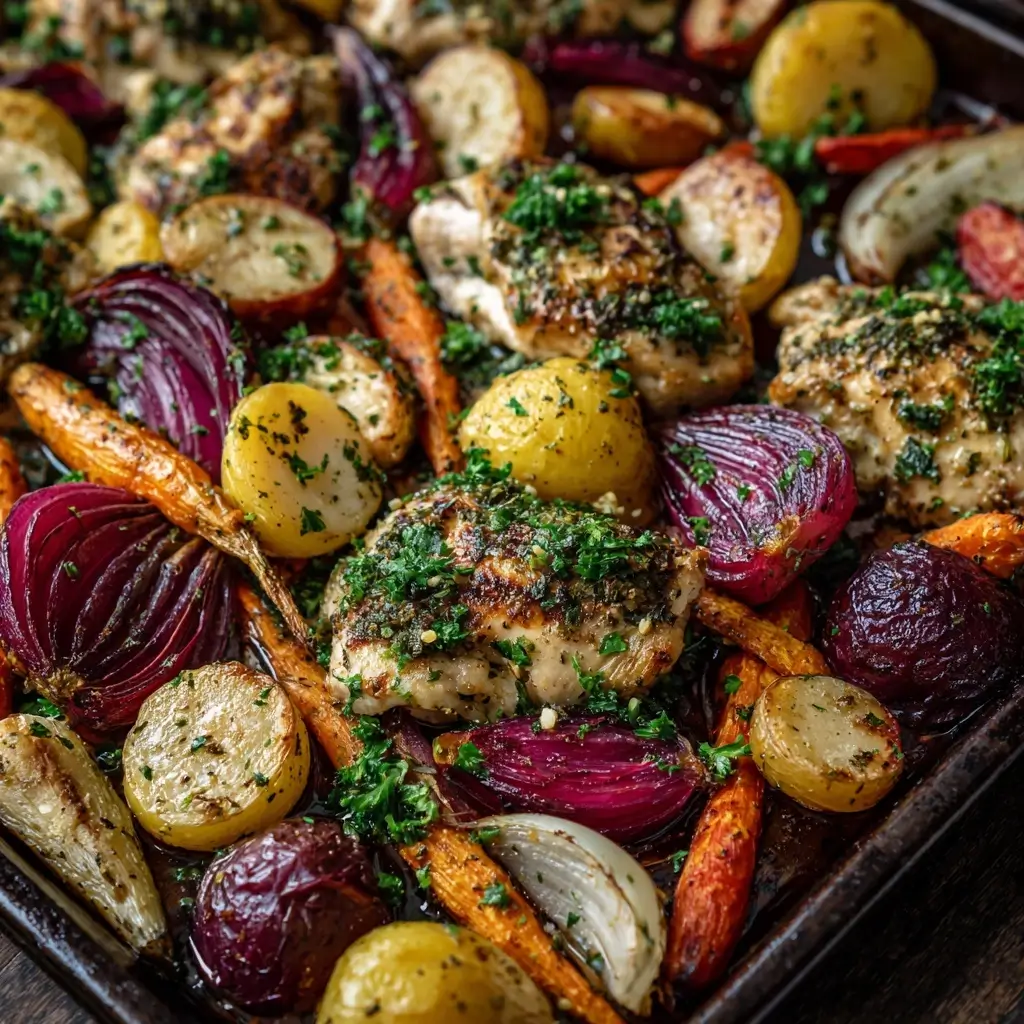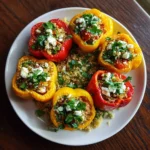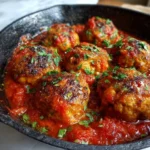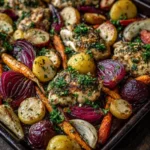Sheet-Pan Garlic Herb Chicken with Root Vegetables: A Complete Guide
The History
The sheet-pan dinner concept has roots in mid-20th century American home cooking, where simplicity and efficiency became kitchen priorities. As families sought quick, nutritious meals without the burden of multiple pots and pans, roasting everything on a single tray emerged as a popular solution. The idea evolved from traditional European roasts—particularly French and Italian methods—where meats and vegetables were slow-cooked together in ovens to develop deep, savory flavors.
Garlic and herbs have long been staples in Mediterranean cuisine, used not only for flavor but also for their preservative and health properties. Ancient civilizations like the Greeks, Romans, and Egyptians revered garlic for its medicinal qualities, while rosemary, thyme, and sage were celebrated for both culinary and symbolic purposes. Combining these aromatic herbs with chicken and root vegetables is a nod to rustic farmhouse cooking, where seasonal ingredients were roasted over open fires or in wood-burning ovens.
In modern times, the sheet-pan meal trend exploded with the rise of meal prep culture, clean eating movements, and food blogs around the 2010s. Social media platforms amplified recipes that promised minimal cleanup and maximum flavor, making Sheet-Pan Garlic Herb Chicken with Root Vegetables a staple in kitchens across North America and beyond. It’s now considered a hallmark of practical, wholesome cooking—ideal for busy weeknights, family dinners, and even holiday side dishes when adapted appropriately.
Ingredients Breakdown
Every ingredient in this recipe plays a vital role in creating a balanced, flavorful, and visually appealing dish. Let’s dive into each component:
- Chicken Thighs (Bone-in, Skin-on): These are preferred over breasts because they stay juicy during roasting, thanks to their higher fat content. The skin crisps beautifully under high heat, adding texture and richness.
- Olive Oil: Extra-virgin olive oil serves as the base for the herb marinade, helping distribute flavors evenly and promoting caramelization of both chicken and vegetables.
- Fresh Garlic: Minced fresh garlic infuses the oil with pungent aroma and depth. When roasted, it mellows into a sweet, nutty essence that permeates every bite.
- Fresh Rosemary: Earthy and slightly pine-like, rosemary pairs exceptionally well with poultry and root vegetables. Its robust flavor holds up to long roasting times.
- Fresh Thyme: Delicate yet fragrant, thyme adds a subtle floral note that complements the other herbs without overpowering them.
- Salt and Black Pepper: Essential seasonings that enhance all other flavors. Kosher salt is recommended for its clean taste and easy distribution.
- Paprika (Optional): Adds a hint of warmth and color without significant heat, enhancing the visual appeal of the chicken skin.
- Carrots: Sweet and fibrous, carrots caramelize nicely in the oven, developing a tender texture and concentrated natural sugars.
- Parsnips: Similar to carrots but with a more complex, slightly peppery-sweet profile. They add dimension and balance to the vegetable medley.
- Turnips: Often overlooked, turnips bring a mild radish-like sharpness that cuts through the richness of the chicken, especially when roasted until golden.
- Red Potatoes: Waxy varieties like red bliss hold their shape well during roasting and absorb the garlicky herb oil beautifully.
- Onion (Yellow or Red): Sliced onions contribute sweetness and moisture, helping create a flavorful fond at the bottom of the pan.
- Lemon Zest (Optional): A small amount brightens the entire dish, lifting the heavy notes of meat and root vegetables with citrus freshness.
- Fresh Parsley (for garnish): Added after roasting, parsley brings a pop of green and a fresh, grassy finish.
Step-by-Step Recipe
- Preheat the Oven: Set your oven to 400°F (205°C). This temperature ensures even cooking, crisp skin, and well-caramelized vegetables without drying out the chicken.
- Prepare the Chicken: Pat the chicken thighs dry with paper towels—this step is crucial for achieving crispy skin. Place them in a large mixing bowl.
- Make the Herb Marinade: In a small bowl, combine 1/3 cup extra-virgin olive oil, 6 cloves of minced garlic, 1 tablespoon chopped fresh rosemary, 1 tablespoon chopped fresh thyme, 1 teaspoon kosher salt, 1/2 teaspoon black pepper, and 1/2 teaspoon paprika (if using). Whisk thoroughly to emulsify.
- Marinate the Chicken: Pour half of the herb oil mixture over the chicken thighs, making sure to coat both sides, including underneath the skin. Use your hands to gently massage the marinade into the meat. Allow to sit for at least 15 minutes at room temperature (or up to 2 hours in the fridge for deeper flavor).
- Chop the Vegetables: While the chicken marinates, peel and cut 3 large carrots into 1-inch chunks. Peel and cube 2 parsnips similarly. Quarter 1 pound of red potatoes (no need to peel). Cut 1 medium turnip into eighths. Halve one large yellow onion and slice into wedges.
- Toss Vegetables with Oil: Place all chopped vegetables in a large bowl. Drizzle with the remaining half of the herb oil, tossing until evenly coated. Season lightly with additional salt and pepper if desired.
- Arrange on Sheet Pan: Line a rimmed baking sheet with parchment paper or lightly grease it with oil to prevent sticking. Spread the vegetables in a single layer, ensuring space between pieces for proper roasting. Nestle the marinated chicken thighs on top, skin-side up, spacing them evenly across the pan.
- Rose the Chicken and Vegetables: Place the sheet pan in the preheated oven and roast for 35–40 minutes. Halfway through (around the 20-minute mark), use tongs to flip the vegetables gently for even browning. Do not flip the chicken; let the skin crisp undisturbed.
- Check for Doneness: The chicken is done when the internal temperature reaches 165°F (74°C) at the thickest part, and the juices run clear. The vegetables should be fork-tender and lightly browned at the edges.
- Rest and Garnish: Remove the pan from the oven and let the chicken rest for 5–10 minutes. This allows the juices to redistribute, ensuring moist meat. Sprinkle with freshly chopped parsley and a pinch of lemon zest for brightness.
- Serve: Transfer everything to a serving platter or divide directly onto plates. Spoon any pan juices over the top for added flavor.
Tips
- Uniform Cutting: Cut all vegetables to similar sizes so they cook evenly. Larger chunks may remain undercooked, while smaller ones can burn.
- Dry Chicken = Crispy Skin: Always pat chicken dry before seasoning. Moisture is the enemy of crispiness.
- Don’t Overcrowd the Pan: Use a large enough sheet pan (at least 13×18 inches). If the pan is too small, steam will build up, preventing proper browning.
- Use Fresh Herbs: While dried herbs can work in a pinch, fresh rosemary and thyme provide superior aroma and flavor, especially when roasted.
- High Smoke Point Oil: Stick to olive oil for flavor, but avoid overheating it beyond its smoke point. For higher heat roasting (above 425°F), consider avocado oil.
- Roast Rack Option: For extra-crispy chicken skin, place the chicken on a wire rack set over the sheet pan. This allows hot air to circulate underneath.
- Save the Juices: The pan drippings are liquid gold! Skim off excess fat and drizzle over servings or use as a base for gravy.
- Prep Ahead: Chop vegetables and make the herb oil the night before. Store separately in airtight containers. Marinate chicken up to 12 hours ahead for deeper flavor infusion.
Variations and Customizations
This recipe is incredibly adaptable based on dietary preferences, seasonal availability, and global flavor inspirations:
- Keto/Low-Carb Version: Replace potatoes and carrots with low-carb alternatives like radishes, cauliflower florets, zucchini, or bell peppers. Radishes mimic potatoes when roasted and won’t spike blood sugar.
- Vegetarian Option: Omit chicken and double the vegetables. Add chickpeas or tofu cubes tossed in the same herb oil for protein. Roast until golden and slightly crisp.
- Mediterranean Twist: Add cherry tomatoes, kalamata olives, and artichoke hearts during the last 15 minutes of roasting. Finish with crumbled feta and a drizzle of balsamic glaze.
- Spicy Kick: Add crushed red pepper flakes to the herb oil or toss vegetables with harissa paste for North African flair.
- Citrus Infusion: Place lemon or orange slices beneath the chicken or scatter over vegetables before roasting. The fruit releases juice and aroma as it cooks.
- Herb Swaps: Try tarragon for a French twist, dill for a lighter spring version, or oregano for bold Mediterranean taste.
- Dairy-Free & Gluten-Free Friendly: This recipe is naturally gluten-free and dairy-free, making it ideal for various dietary restrictions.
- Holiday Upgrade: Add cubed butternut squash, apples, or chestnuts for a festive autumn or winter variation. Perfect alongside stuffing or cranberry sauce.
Health Considerations and Nutritional Value
Sheet-Pan Garlic Herb Chicken with Root Vegetables is not just delicious—it’s nutritionally balanced, offering protein, fiber, vitamins, and healthy fats.
Nutritional Highlights (per serving, approx. 1 thigh + 1.5 cups vegetables):
- Calories: ~420–480 kcal
- Protein: 28–32g (supports muscle repair and satiety)
- Fat: 22–26g (mostly heart-healthy monounsaturated fats from olive oil)
- Carbohydrates: 30–35g (complex carbs from root veggies)
- Fiber: 6–8g (promotes digestive health)
- Vitamin A: High (from carrots and greens—great for vision and immunity)
- Vitamin C: Moderate (especially with lemon zest)
- Potassium: Good source (from potatoes and parsnips—helps regulate blood pressure)
- Iron and Zinc: Present (from chicken—essential for immune function and energy metabolism)
Health Benefits:
- Heart-Healthy Fats: Olive oil contains antioxidants and anti-inflammatory compounds like oleocanthal.
- Blood Sugar Control: Fiber-rich vegetables help stabilize glucose levels, especially when paired with lean protein.
- Immune Support: Garlic contains allicin, which has antimicrobial and immune-boosting properties.
- Digestive Wellness: The variety of vegetables provides diverse phytonutrients and prebiotic fibers.
Considerations:
- For lower sodium intake, reduce added salt and rely on herbs, garlic, and citrus for flavor.
- Skinless chicken thighs reduce saturated fat content slightly, though the skin contributes to flavor and satisfaction.
- Those managing diabetes should monitor portion sizes of starchy vegetables like potatoes and carrots.
Ingredients
- 6 bone-in, skin-on chicken thighs (about 2.5 lbs total)
- 1/3 cup extra-virgin olive oil
- 6 cloves garlic, minced
- 1 tbsp fresh rosemary, finely chopped
- 1 tbsp fresh thyme leaves
- 1 tsp kosher salt (plus more to taste)
- 1/2 tsp freshly ground black pepper
- 1/2 tsp paprika (optional, for color and warmth)
- 3 large carrots, peeled and cut into 1-inch pieces
- 2 parsnips, peeled and cut into 1-inch chunks
- 1 lb red potatoes, quartered
- 1 medium turnip, peeled and cut into eighths
- 1 large yellow onion, halved and sliced into wedges
- 1 tsp lemon zest (optional)
- 2 tbsp fresh parsley, chopped (for garnish)
Directions
- Preheat oven to 400°F (205°C). Line a large rimmed baking sheet with parchment paper or lightly grease it.
- In a small bowl, whisk together olive oil, minced garlic, rosemary, thyme, salt, pepper, and paprika.
- Pat chicken thighs dry with paper towels. Place in a bowl and pour half the herb oil over them. Massage thoroughly, including under the skin. Let sit for 15–30 minutes.
- While chicken rests, prepare all vegetables. Place them in a large bowl and toss with the remaining herb oil until evenly coated.
- Spread vegetables in a single layer on the prepared sheet pan. Arrange chicken thighs on top, skin-side up, spaced apart.
- Raise in the preheated oven for 35–40 minutes, flipping vegetables halfway through, until chicken reaches 165°F internally and skin is golden and crisp.
- Remove from oven and let chicken rest for 5–10 minutes. Garnish with parsley and lemon zest.
- Serve warm, spooning pan juices over the top for enhanced flavor.
FAQ
Can I use chicken breasts instead of thighs?
Yes, but breasts cook faster and can dry out. Reduce roasting time to 25–30 minutes and check early. Consider brining first for juiciness.
Can I make this ahead of time?
Absolutely. Chop veggies and marinate chicken up to 24 hours in advance. Roast just before serving. Leftovers keep well for 3–4 days in the fridge.
Can I freeze this dish?
Yes. Fully cooked and cooled, it freezes well for up to 3 months. Reheat in the oven at 350°F until warmed through.
Why are my vegetables soggy?
Likely due to overcrowding or not preheating the pan. Ensure a single layer and avoid covering the pan during roasting.
Can I add other vegetables?
Definitely! Try beets, sweet potatoes, Brussels sprouts, or celery root. Adjust size and density accordingly.
Is this recipe suitable for meal prep?
Perfect for meal prep! Divide into containers for up to 4 days. Reheat in the oven or microwave. Keeps flavors intact and textures hold up well.
How do I get crispier chicken skin?
Broil for the last 2–3 minutes, watching closely. Or start roasting at 425°F for 15 minutes, then reduce to 375°F to finish.
Summary
Sheet-Pan Garlic Herb Chicken with Root Vegetables is a foolproof, wholesome meal that combines juicy herb-marinated chicken with caramelized seasonal vegetables—all roasted on one pan for easy cleanup. Packed with flavor, nutrients, and endless customization options, it’s the ultimate weeknight hero dish.










